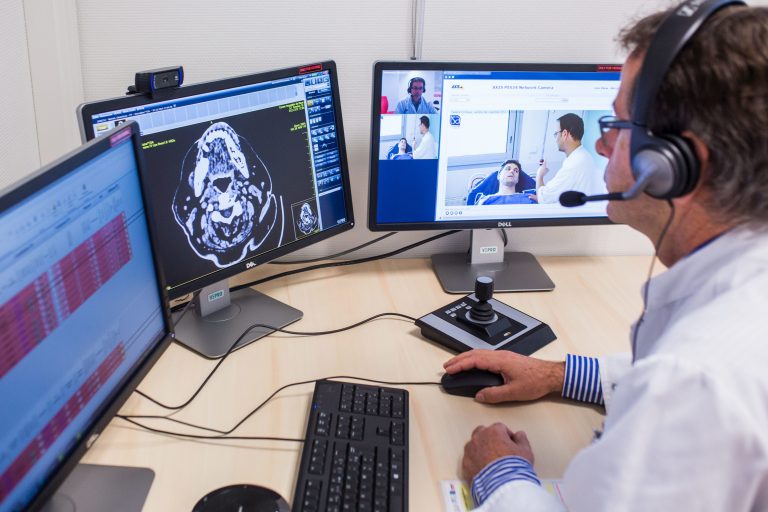5 challenges in cooperation with the hybrid team
The complete transition of a company to remote work is not always possible, if only due to the need for physical meetings with the client or the lack of access to technologies and systems at home. In such situations, a hybrid model is a good solution. It consists in the fact that some of the company’s employees work from the office, and some completely or partially remotely. Such a model often turns out to be better suited not only to business needs, but also to the needs of employees – especially those who feel much better at the office reality.
Cooperation with a hybrid team brings however, there are completely different challenges than traditional remote work. It is not a homogeneous team, as in the case of 100% remote work or stationary work in the office. In such a model, we must always remember the needs and problems of two groups, combine their interests and ensure that they do not become separate organisms. After all, all employees are part of one company and act in the common interest.
Challenges of working in a hybrid team
Communication gaps
Imagine this situation: you send an email notification to the entire company about important changes in the project you are currently working on. You make sure that the e-mail reaches everyone in the company and that no one feels left out. A few minutes after the email is sent, your colleague from the next desk asks you a question about the content of your message. After a while, more people from the open space join the conversation. As a result, a discussion opens and you come to important and valuable conclusions. It’s just that remote workers, for obvious reasons, could not participate in it and during work on this project they will naturally be in a worse position than the people who took part in the interview. Therefore, it will be necessary to spend more time introducing them to the topic and presenting new findings.
These things are happening in hybrid teams, and will be happening. Even the best communication strategy in the company will not prevent office workers from exchanging messages during the lunch break or in the queue for the coffee machine. Therefore, it is important to train employees to document all live meetings and conversations that may be relevant to the work of the entire team. It is good to adopt a rule that what is not communicated by e-mail or otherwise to all employees affected by the topic is only an informal conversation and is not binding in any way
Alienating remote workers
Remote workers may feel alienated in the hybrid team. They don’t see the stationary team every day, so their contact is often limited to e-mails and business meetings. It may also happen that the opinions of people working remotely will be taken into account only in the second place, because the team does not know these people so well, so they prefer to trust the person with whom they come into contact every day. This will frustrate remote workers and make it difficult to build a sense of belonging to the company. That is why it is so important that cooperation in a hybrid team is based on team integration, with great emphasis on getting to know stationary and remote employees. The company should take care of integration initiatives that will take place online, such as a thematic day on Slack, gamification between teams or informal Zoom meetings. In addition, remember that no online integration can replace a live meeting. So it is worth making sure that all employees have the opportunity to meet “in real” from time to time.

Unabated technology
In hybrid teams all meetings take place partially remotely, and partially stationary. At first glance, everything sounds very simple, all you need is a laptop with a webcam. But let’s imagine that we are a remote employee who only sees one or two people from the office on his computer screen, because only that many fits in the frame of the computer webcam. In addition, he hears well only the voice of people sitting closest to the computer, and if there is any dialogue between the people sitting there in the office, he hears only noise and individual words. In such conditions, is it possible to fully participate in the meeting and is it a full participant?
It is the company’s responsibility to ensure that technology does not discriminate against any employee. Therefore, we must take care of such technical solutions that everyone can be a full participant in the meeting. This is not something worth saving on, so let’s create a video room in the office or think about other solutions that are best suited to the company. It is important to consult all the people who will be using it when choosing a solution and make a decision based on their real needs.
A challenge for managers
For managers, managing a hybrid team is doubly difficult, especially if they are not properly prepared for it. First, they have to face their own vision and opinion about remote work . If they have not dealt with it before, they may have a stereotypical image of a remote employee who sits in his pajamas at the computer and during work sets the laundry, cooks dinner and does other things not related to work. Such a picture will certainly not help build trust in the remote employee. Therefore, it is necessary to show managers how remote work really looks like and train them in the field of accounting for tasks and employee control. Thanks to this, we will avoid a situation in which remote employees are controlled 3 times more often than office workers. The key to success is trust and the same standards for both groups – remote and stationary.
Moreover, managers have to struggle every day with reconciling the interests of all their subordinates and taking care of relations between them. It is largely up to them to ensure that home workers do not feel alienated and are full members of the team. Therefore, leaders must be provided with the knowledge and resources to help them manage team relationships.
Less development opportunities
Remote workers in hybrid teams are out of sight most of the time, and their hard work is not as visible as people in the office. As a result, they can be left out of interviews about promotion or other development opportunities. In the higher structures of the company, among managers or management board, there may also appear resistance to entrusting a more responsible position to a person whom we do not see every day in the office, which further reduces the chances of remote employees to develop in the company.
Moreover, the remote workers’ opinion can be far less powerful. As a consequence, such employees may feel that they have much less influence on changes in the company and shaping their workplace. As a result, we can expect that such a person is more likely to move to another company, if only he is offered more responsibility. After all, in our company she will not see any prospects for further development.
That is why it is so important to sensitize all employees, especially decision-makers, not to divide people into remote and stationary workers in any situation, but to make decisions only on the basis of results and competences.
Summary
Creating hybrid teams in the company will be a good solution in many cases. Remote work provides us with a number of business benefits, first of all we gain access to qualified employees who do not live near our company’s headquarters. We can also meet the expectations of candidates who more and more often expect remote work and work more effectively in this mode. However, we must remember that a hybrid team is different from both a stationary team and a fully remote team.
The key to success is the equal treatment of all employees at every stage of decision-making related to the company and taking into account the interests of remote workers and office workers.
We hope you already know how correct cooperation with the hybrid team should look like.







